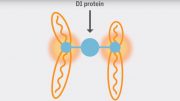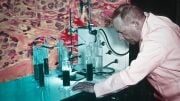
An innovative membrane that captures carbon dioxide from the air using humidity differences has been developed. This energy-efficient method could help meet climate goals by offering a sustainable carbon dioxide source for various applications. (Artist’s concept.) Credit: SciTechDaily.com
A new membrane technology developed by Newcastle University leverages humidity to efficiently capture carbon dioxide, offering a promising solution for sustainable direct air capture essential for achieving climate targets.
Direct air capture was identified as one of the ‘Seven chemical separations to change the world’. This is because although carbon dioxide is the main contributor to climate change (we release ~40 billion tons into the atmosphere every year), separating carbon dioxide from air is very challenging due to its dilute concentration (~0.04%).
Challenges in Carbon Dioxide Separation
Prof Ian Metcalfe, Royal Academy of Engineering Chair in Emerging Technologies in the School of Engineering, Newcastle University, UK, and lead investigator states, “Dilute separation processes are the most challenging separations to perform for two key reasons. First, due to the low concentration, the kinetics (speed) of chemical reactions targeting the removal of the dilute component are very slow. Second, concentrating the dilute component requires a lot of energy.”
These are the two challenges that the Newcastle researchers (with colleagues at the Victoria University of Wellington, New Zealand, Imperial College London, UK, Oxford University, UK, Strathclyde University, UK, and UCL, UK) set out to address with their new membrane process. By using naturally occurring humidity differences as a driving force for pumping carbon dioxide out of air, the team overcame the energy challenge. The presence of water also accelerated the transport of carbon dioxide through the membrane, tackling the kinetic challenge.
Innovations in Membrane Technology
The work is published in Nature Energy and Dr. Greg A. Mutch, Royal Academy of Engineering Fellow in the School of Engineering, Newcastle University, UK explains, “Direct air capture will be a key component of the energy system of the future. It will be needed to capture the emissions from mobile, distributed sources of carbon dioxide that cannot easily be decarbonized in other ways.”
“In our work, we demonstrate the first synthetic membrane capable of capturing carbon dioxide from air and increasing its concentration without a traditional energy input like heat or pressure. I think a helpful analogy might be a water wheel on a flour mill. Whereas a mill uses the downhill transport of water to drive milling, we use it to pump carbon dioxide out of the air.”
Separation Processes
Separation processes underpin most aspects of modern life. From the food we eat, to the medicines we take, and the fuels or batteries in our car, most products we use have been through several separation processes. Moreover, separation processes are important for minimizing waste and the need for environmental remediation, such as direct air capture of carbon dioxide.
However, in a world moving towards a circular economy, separation processes will become even more critical. Here, direct air capture might be used to provide carbon dioxide as a feedstock for making many of the hydrocarbon products we use today, but in a carbon-neutral, or even carbon-negative, cycle.
Most importantly, alongside transitioning to renewable energy and traditional carbon capture from point sources like power plants, direct air capture is necessary for realizing climate targets, such as the 1.5 °C goal set by the Paris Agreement.
Humidity-Driven Carbon Capture
Dr. Evangelos Papaioannou, Senior Lecturer in the School of Engineering, Newcastle University, UK explains, “In a departure from typical membrane operation, and as described in the research paper, the team tested a new carbon dioxide-permeable membrane with a variety of humidity differences applied across it. When the humidity was higher on the output side of the membrane, the membrane spontaneously pumped carbon dioxide into that output stream.”
Collaborative Efforts and Future Directions
Using X-ray micro-computed tomography with collaborators at UCL and the University of Oxford, the team was able to precisely characterize the structure of the membrane. This enabled them to provide robust performance comparisons with other state-of-the-art membranes.
A key aspect of the work was modeling the processes occurring in the membrane at the molecular scale. Using density-functional-theory calculations with a collaborator affiliated to both Victoria University of Wellington and Imperial College London, the team identified ‘carriers’ within the membrane. The carrier uniquely transports both carbon dioxide and water but nothing else. Water is required to release carbon dioxide from the membrane, and carbon dioxide is required to release water. Because of this, the energy from a humidity difference can be used to drive carbon dioxide through the membrane from a low concentration to a higher concentration.
Prof Metcalfe adds, “This was a real team effort over several years. We are very grateful for the contributions from our collaborators, and for the support from the Royal Academy of Engineering and the Engineering & Physical Sciences Research Council.”
Reference: “Separation and concentration of carbon dioxide from air using a humidity-driven molten-carbonate membrane” by I.S. Metcalfe, G.A. Mutch, E.I. Papaioannou, S. Tsochataridou, D. Neagu, D.J.L. Brett, F. Iacoviello, T.S. Miller, P.R. Shearing, P.A. Hunt, 19 July 2024, Nature Energy.
DOI: 10.1038/s41560-024-01588-6









Be the first to comment on "Carbon Capture Breakthrough: Humidity-Powered Membrane Pumps CO2 out of the Air"